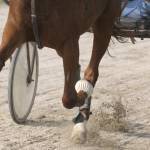Regenerative Therapy Review: ACS for Horse Joints

Even if an owner coddled a foal from birth, allowing him to work and play on only the best footing, chances are he will still develop osteoarthritis (OA) at some point in his life. This explains why OA, a progressive, painful degeneration of joints that often limits a horse’s ability to perform and compete, remains a point of interest among researchers.
Osteoarthritis usually develops whenever abnormal stresses or abnormal joint anatomy occurs.
- Foals are sometimes born with abnormally shaped bones or joints, such as incomplete ossification or hardening of the small cuboidal bones in the knee or hock;
- Foals can develop angular limb deformities or other developmental orthopedic diseases such as osteochondritis dissecans (OCD);
- Horses may experience trauma to a joint not only during training or competing but also meandering in a pasture or cavorting with peers; and
- Normal wear and tear on the musculoskeletal system from a lifetime of exercise in an ageing horse.
“Although no cure has been identified, multiple research-based strategies exist to help minimize or delay the development and severity of OA,” explained Kathleen Crandell, Ph.D., a Kentucky Equine Research nutritionist. “Appropriate nutrition, including the use of oral joint health supplements prior to any trauma or wear and tear can help protect joints throughout a horse’s life.”
KER offers several joint supplements that could fit the bill, including:
- EO•3 contains marine-derived omega-3 fatty acids that possess inherent anti-inflammatory properties;
- Synovate HA features hyaluronic acid to help lubricate horse’s joints; and
- KER•Flex includes glucosamine and chondroitin sulfate (Glucos-A-Flex in Australia).
Medical options include administration of anti-inflammatory drugs and regenerative therapies, including stem cells and autologous conditioned serum (ACS), also known as IRAP or interleukin-1 receptor agonist protein therapy.
In a nutshell, ACS uses a small volume of blood collected from the patient to treat its own joint disease (the word autologous means self-derived). After letting the blood clot, the resulting serum, or liquid portion of blood, is mixed with special beads included in a commercial ACS kit. This incubation process stimulates the production of anti-inflammatory molecules, most importantly IRAP. This “conditioned” serum is then injected into the target joint of the horse to inhibit inflammation.
Studies support this technique, showing that horses with experimentally induced OA treated with IRAP had a significant improvement in lameness as well as microscopic evidence of healing joint tissues.
“Maintaining an appropriate body condition score throughout a horse’s life and keeping horses active also play important roles in supporting joint health,” Crandell reminded.








